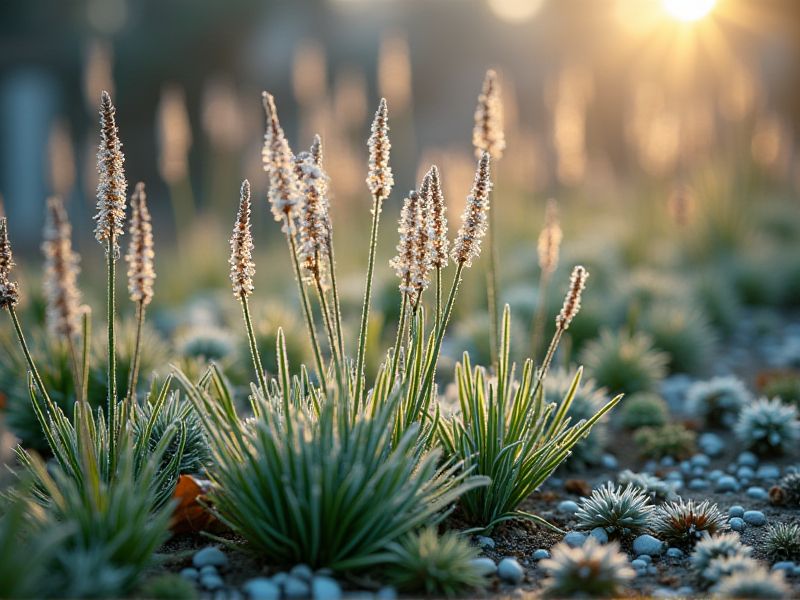
Winter-hardy plants, such as Hellebores and Heucheras, thrive in colder climates and can tolerate frost without significant damage. Perennials like Sedum and Echinacea exhibit resilience, returning year after year, providing vibrant blooms even in harsh conditions. Many of these frost-tolerant varieties, including ornamental grasses like Miscanthus, add texture and interest to winter gardens. If you live in a region prone to freezing temperatures, consider incorporating evergreen shrubs like Boxwood or Holly for year-round greenery. Proper mulching and strategic placement can enhance the survivability of these hardy species, ensuring your garden remains visually appealing throughout the winter months.
List of some Winter-hardy plants that withstand frost
- Siberian Iris (Iris sibirica)
- Common Tansy (Tanacetum vulgare)
- Yarrow (Achillea millefolium)
- Russian Sage (Perovskia atriplicifolia)
- Black-eyed Susan (Rudbeckia hirta)
- Coneflower (Echinacea purpurea)
- Hellebore (Helleborus orientalis)
- Lungwort (Pulmonaria officinalis)
- Bergenia (Bergenia cordifolia)
- Pansy (Viola tricolor)
Important things about Winter-hardy plants that withstand frost
Definition Of Winter-Hardy Plants
Winter-hardy plants are species that can endure freezing temperatures and frost without succumbing to damage. These resilient plants often have specialized adaptations, such as tougher cell structures or protective outer coatings, which allow them to survive adverse winter conditions. You can find various winter-hardy plants, including perennials like Hellebores and ornamental grasses like Miscanthus, that thrive in temperate climates. Gardening enthusiasts often select these hardy varieties to maintain vibrant landscapes even during the harshest months of winter.
Types Of Frost Resilience
Winter-hardy plants exhibit varying degrees of frost resilience, allowing them to thrive in colder climates. Species such as Hellebores, which bloom early in the spring, can withstand temperatures as low as -15degF, showcasing their exceptional cold tolerance. Perennials like Sedum and certain varieties of Lavender develop deep root systems that help them endure freeze-thaw cycles, ensuring their survival through harsh winters. By selecting frost-resistant plants for your garden, you can create a vibrant landscape that flourishes, even in the frostiest conditions.
Hardiness Zones
Winter-hardy plants thrive in USDA hardiness zones that experience freezing temperatures, making them ideal for colder climates. These plants possess adaptations such as antifreeze proteins and thick insulating foliage that protect them from frost damage. Examples include perennials like Hellebores and ornamental grasses, which not only survive harsh winters but also provide year-round visual interest in your garden. Choosing winter-hardy species ensures a resilient landscape that withstands the challenges of freezing temperatures and fluctuating winter weather conditions.
Growing Conditions Requirements
Winter-hardy plants thrive in regions with cold winters, demonstrating remarkable resilience to frost and sub-zero temperatures. To ensure optimal growth, these plants require well-drained soil that retains moisture without becoming waterlogged, as excessive moisture can lead to root rot. A layer of mulch around the base of each plant helps insulate the roots during freezing temperatures while also suppressing weeds. These plants often benefit from full to partial sunlight exposure, promoting healthy growth even in cooler months.
Native Species Advantages
Winter-hardy plants provide substantial benefits to your garden by enhancing biodiversity and promoting ecological resilience. These native species have adapted to local climates, allowing them to endure frost while minimizing the need for chemical fertilizers and pesticides. By incorporating such plants, you can create habitats for local wildlife, improve soil health, and reduce water usage. Selecting winter-hardy varieties ensures that your landscape remains vibrant and productive during the colder months, even in challenging weather conditions.
Soil Preparation And Drainage
Proper soil preparation is crucial for cultivating winter-hardy plants, as it enhances drainage and prevents root rot during cold months. Incorporating organic matter, such as compost, improves soil structure and nutrient availability, fostering robust plant growth even in frosty conditions. You should consider raised beds that facilitate optimal drainage, which helps prevent water accumulation and subsequent freezing damage to root systems. Selecting frost-resistant species, such as Helleborus or Sedum, ensures vibrant gardens throughout winter, while their resilience supports local ecosystems.
Mulching Benefits
Mulching around winter-hardy plants provides essential insulation, helping to maintain soil temperature and protect delicate root systems from harsh frost. The layer of mulch, typically made from organic materials like wood chips, straw, or shredded leaves, not only conserves moisture but also suppresses weeds that compete for vital nutrients. This practice promotes healthier plant growth by enhancing soil structure and fostering beneficial microbial activity. When choosing plants for cold climates, consider species such as Hellebores, Sedum, and Perennials like Phlox, as they thrive even in the frost, ensuring a robust and vibrant garden throughout the colder months.
Watering Needs During Winter
Winter-hardy plants, such as Hellebores and Sedum, require careful attention to watering during the frost months. These plants thrive in cold conditions but can suffer from desiccation if the soil becomes too dry. It's essential to check the moisture levels regularly, ensuring that the soil remains slightly damp without being waterlogged. You can help your winter-hardy plants thrive by watering them during milder winter days, promoting healthy root development while preventing frost damage.
Pruning Practices For Winter-Hardy Plants
Winter-hardy plants, such as holly, evergreen shrubs, and certain perennials, require specific pruning practices to encourage healthy growth while withstanding frost. Performing light pruning in late winter or early spring, just before new growth begins, helps remove any dead or damaged branches and promotes air circulation. Focus on removing inward-growing branches to maintain shape and encourage a strong structure that can better endure harsh conditions. Ensure your pruning tools are clean and sharp to minimize stress on the plants, giving them the best chance to thrive in fluctuating winter temperatures.
Seasonal Maintenance Tips
Selecting winter-hardy plants for your garden can significantly enhance its resilience against frost. Perennials such as Hellebores and Sedum not only survive freezing temperatures but also add visual interest with their unique textures and colors during the winter months. Mulching around these plants helps retain soil moisture and provides insulation against severe cold, protecting their root systems. Incorporating shrubs like Boxwood provides structure and can serve as windbreaks, ensuring your garden remains vibrant even in harsh winter conditions.
